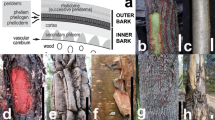Summary
Neblinaria celiae (Theaceae), a rosette shrub endemic to the exceedingly rainy summit of remote Cerro de la Neblina in southern Venezuela, has a previously undescribed set of adaptations to fire. Its growth form entails sparse branching, massive terminal leaf rosettes, and thick bark. It is highly fire-tolerant, with a survival rate of 93% in a stand recently ignited by lightning, vs. 0% in seven co-occurring woody species. Survival increases sharply with rosette height, favoring a sparsely branched habit that would maximize the rate of upward growth through the sparse fuel layer supported by a sterile substrate. Thick bark and massive rosettes help protect cambial and foliar meristems from brief exposure to high temperatures. Rosettes on shorter plants are exposed to greater damage from fire near the ground and, as expected, are bigger and impound more rainwater; the greater number of leaves nearly balances the greater leaf mortality caused by fire. We relate Neblinaria's growth form to its dominance atop Neblina, to a general model for the evolution of sparse branching, and to the evolution of growth form in other tepui plants.
Similar content being viewed by others
References
Beck E, Senser M, Scheibe R, Steiger HM, Pongratz P (1982) Forst avoidance and freezing intolerance in afroalpine “giant rosette” plants. Plant Cell Environ 5:215–222
Beck E, Schulze E-D, Senser M, Scheibe R (1984) Equilibrium freezing of leaf water and extracellular ice formation in afroalpine giant rosette plants. Planta 162:276–282
Brewer Carias C (1976) La Vegetacíon del Mundo Perdido. Fundacíon Eugenio Mendoza, Caracas
Cronquist AS (1980) The Classification of the Flowering Plants. Columbia University Press, New York
Erickson R, George AS, Marchant NG, Morcombe MK (1979) Flowers and plants of Western Australia. Reed, Sydney
Givnish TJ (1978) On the adaptive significance of compound leaves, with particular reference to tropical trees. In: Tomlinson PB, Zimmermann MH (eds) Tropical trees as living systems. Cambridge University Press, Cambridge, pp 351–380
Givnish TJ (1981) Serotiny, geography, and fire in the Pine Barrens of New Jersey. Evol 35:101–123
Givnish TJ (1984) Leaf and canopy adaptations in tropical forests. In: Medina E, Mooney HA, Vasquéz-Yánes C (eds), Physiological Ecology of Plants of the Wet Tropics. Dr Junk, The Hague, pp 54–84
Gleason HA (1931) Botanical results of the Tyler-Duida expedition. Bull Torrey Bot Club 58:277–506
Goldstein G, Meinzer FC (1983) Influence of insulating dead leaves and lower temperatures on water balance in an Andean giant rosette plant. Plant Cell Environ 6:649–656
Goldstein G, Meinzer FC, Monasterio M (1984) The role of capacitance in the water balance of Andean giant rosette species. Plant Cell Environ 7:179–185
Hedberg O (1964) Features of afroalpine plant ecology. Acta Phytogeogr Suec 49:1–144
Huber O (1982) Significance of savanna vegetation in the Amazonas Territory of Venezuela. In: Prance GT (ed), Biological diversification in the tropics. Columbia University Press, New York, pp 221–244
Huber O, Steyermark JA, Prance Gt, Ales C (1984) The vegetation of the Sierra Parima, Venezuela-Brazil: some results of recent exploration. Brittonia 36:104–139
Leighton M, Wirawan N (1986) Catastrophic drought and fire in Borneo rain forests associated with the 1982–83 El Niño Southern Oscillation event. In: Prance GT (ed) Tropical Rain Forests and the World Atmosphere. Westview, Boulder, pp 83–107
Maguire B (1955) Cerro de la Neblina, Amazonas, Venezuela: a newly discovered sandstone mountain. Geograph Rev 45:27–51
Maguire B (1970) On the flora of the Guayana Highland. Biotropica 2:85–100
Maguire B (1972) The botany of the Guayana Highland—Part IX. Mem New York Bot Gard 23:1–832
Meinzer F, Goldstein G (1986) Adaptations for water and thermal balance in Andean giant rosette plants. In: Givnish TJ (ed), On the Economy of Plant Form and Function. Cambridge University Press, Cambridge, pp 381–411
Sanford RL Jr, Saldarriaga J, Clark KE, Uhl C, Herra R (1985) Amazon rain-forest fires. Science 227:53–55
Smith AP (1974) Bud temperature in relation to nyctinastic leaf movement in an Andean giant rosette plant. Biotropica 6:263–266
Smith AP (1979) The function of dead leaves in Espeletia schultzii (Compositae), an Andean giant rosette plant. Biotropica 11:43–47
Smith AP (1981) Growth and population dynamics of Espeletia (Compositae) of the Venezuelan Andes. Smithson Contrib Bot 48:1–45
Steyermark JA (1966) Flora del Ptari-tepui. Acta Bot Venez 1:30–270
Steyrmark JA (1967) Flora del Auyan-tepui. Acta Bot Venez 2:5–370
Steyermark JA (1984) Notes on some genera of the Theaceae (Bonnetiaceae). Ann Mo Bot Gard 71:327–330
Steyermark JA, Maguire B (1967) Botany of the Chimanta massif, II. Mem New York Bot Gard 17:440–464
Steyermark JA, Maguire B (1972) The flora of the Meseta del Cerro Jaua. Mem New York Bot Gard 23:833–892
Author information
Authors and Affiliations
Rights and permissions
About this article
Cite this article
Givnish, T.J., McDiarmid, R.W. & Buck, W.R. Fire adaptation in Neblinaria celiae (Theaceae), a high-elevation rosette shrub endemic to a wet equatorial tepui. Oecologia 70, 481–485 (1986). https://doi.org/10.1007/BF00379892
Received:
Issue Date:
DOI: https://doi.org/10.1007/BF00379892




